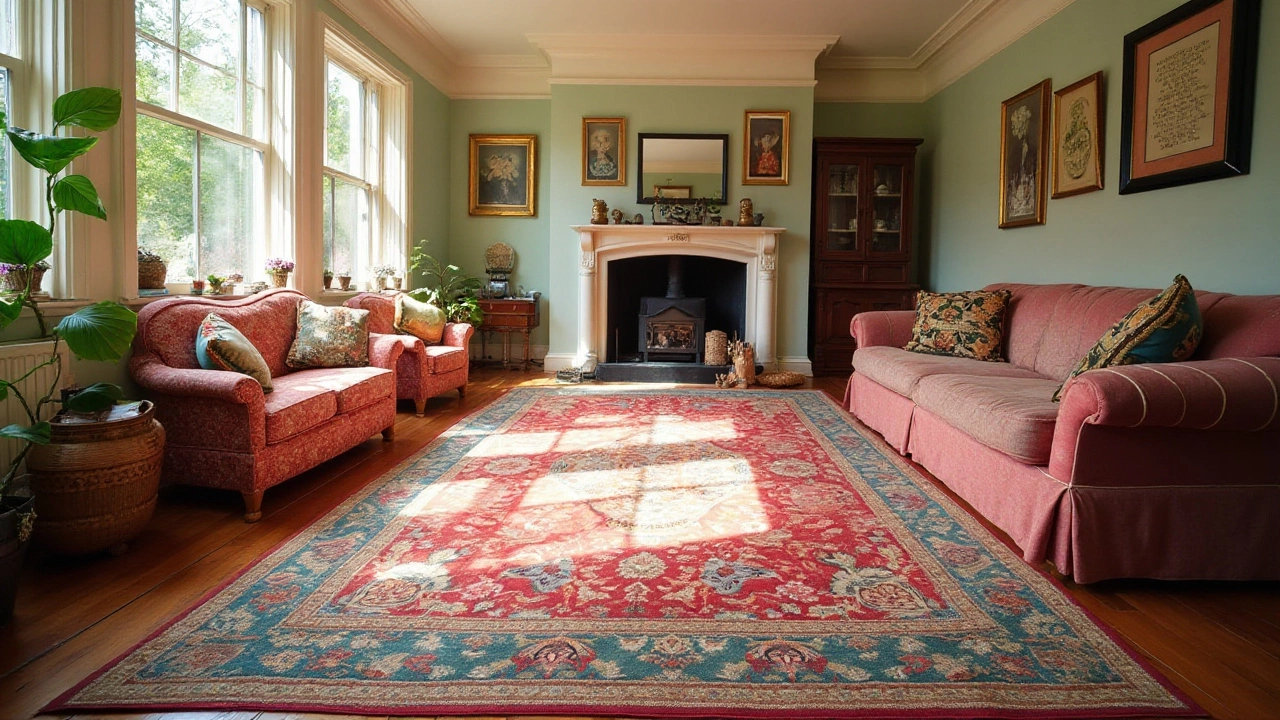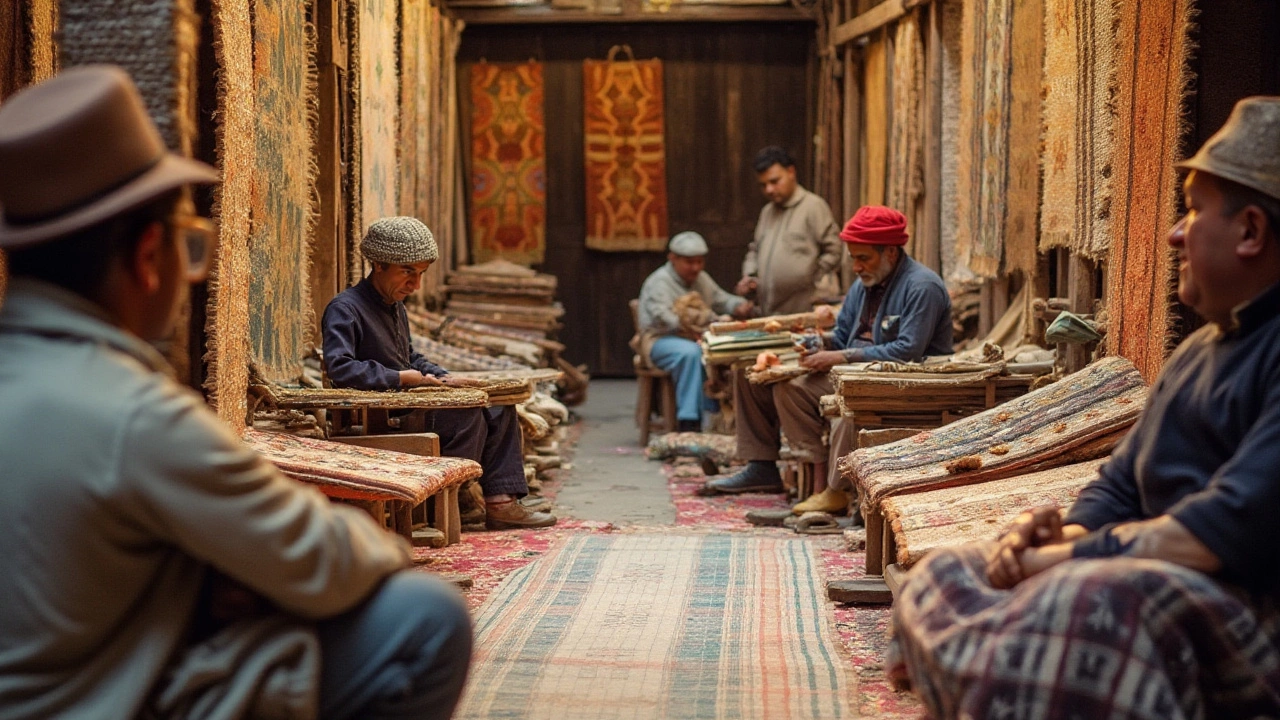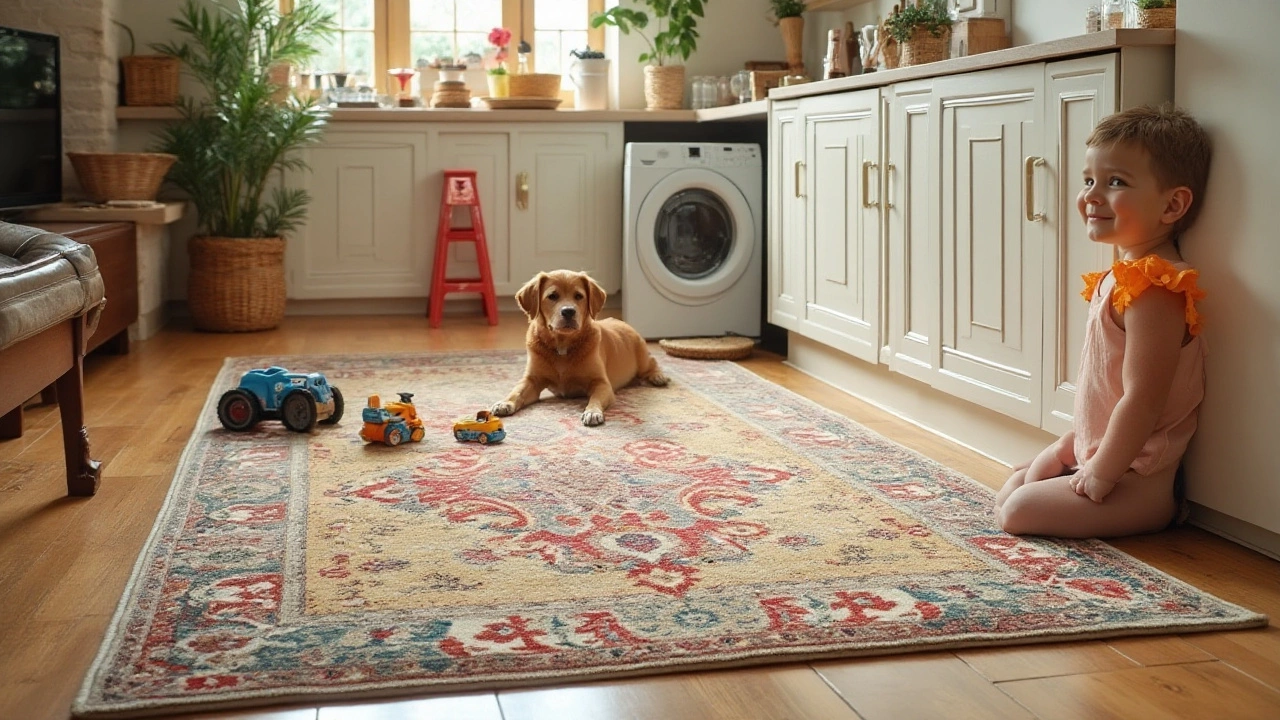Durability Guide: Choosing the Longest-Lasting Area Rugs
 Jan, 13 2025
Jan, 13 2025
When you're selecting an area rug, one of the most important factors to consider is its longevity. Home decor should not only add aesthetic value but also withstand the daily hustle and bustle of life. A durable rug can be a worthwhile investment, staying with you for years and evolving along with your style.
To pick a rug that will stand up to time and traffic, it's helpful to know what goes into making a rug last. From the materials used to the way they are put together, several elements contribute to a rug's durability. Not all rugs are created equal, and understanding the strengths of different options will lead to a more informed choice.
Whether you're looking to jazz up your living room or need a sturdy floor covering for the hallway, knowing what gives a rug its strength will help you choose the best fit for your home. Dive into this guide and discover how you can select a long-lasting rug that ticks all the boxes in terms of style, durability, and care.
- Understanding Rug Materials
- Construction Techniques and Longevity
- Rug Maintenance and Care
- Top Picks for High-Traffic Areas
- Eco-Friendly Durable Rugs
Understanding Rug Materials
Selecting the right material for your durable rugs can make all the difference in longevity and performance. The choice of materials doesn't only dictate the look and feel of the rug, but also its capacity to withstand wear and tear. Wool, for instance, is a popular choice known for its resilience and durability. This natural fiber is excellent at repelling stains and often seen in long-lasting rugs. Due to the natural oil called lanolin, wool rugs maintain their vibrant appearance even after years of usage. Investing in a wool area rug might seem like a splurge, but its lifespan and the ease of maintenance can justify the initial cost.
Synthetic materials such as nylon, polyester, and polypropylene have revolutionized the rug industry by providing robust, cost-effective choices. Nylon rugs are particularly praised for their elasticity and strength, which make them suitable for high-traffic areas. A big plus for nylon is its ability to bounce back into shape, resisting crushing under heavy furniture. On the other hand, polypropylene, also known as olefin, offers superior moisture-wicking properties. This makes it a great candidate for outdoor spaces or damp locations.
Another enduring choice is the sisal or jute rug. These natural fibers are derived from plant material, bringing a unique textural look to your floor. While they aren’t as plush as wool or synthetics, they are incredibly sturdy and eco-friendly. A word of caution: sisal rugs can be sensitive to moisture, so it’s wise to keep them in dry areas. A
Terry White, a notable interior designer, states, “Natural fibers like sisal and wool not only offer durability but also infuse a space with organic warmth that synthetic materials can't mimic.”This highlights the aesthetic versatility and the tactile experience natural fibers bring to the home decor scenery.
For those weighing environmental impact alongside durability, consider bamboo silk. While not as traditional as some fibers, bamboo silk provides a luxurious sheen and is sustainably sourced. Its eco-friendly nature combined with a soft touch makes it an intriguing option for those concerned with sustainability and aesthetics. Tables below showcase a comparison, compiling important aspects such as resilience, ease of cleaning, and cost-effectiveness among various materials.
| Material | Resilience | Maintenance Ease | Cost-Effectiveness |
|---|---|---|---|
| Wool | High | Moderate | High Initial Cost |
| Nylon | Very High | Easy | Moderate |
| Polypropylene | Moderate | Easy | Low |
| Sisal/Jute | High | Challenging | Moderate |
| Bamboo Silk | Moderate | Moderate | High |
In making a choice warmer for your home, knowing these specific strengths and unique characteristics of various rug materials helps ensure your selection fits both practical and personal criteria. Each material offers a different palette of benefits weighted differently based on individual preferences and location. This conscious and informed choice around the composition of your rugs is a rewarding reflection toward creating a long-lasting, beautiful space.
Construction Techniques and Longevity
When it comes to the durability of area rugs, the construction technique plays a pivotal role. While material choice is undeniably important, how the fibers are woven or tufted can dramatically affect a rug's lifespan. One of the oldest and most respected rug-making methods is hand-knotting. This labor-intensive technique results in a rug that can last for decades, if not centuries. The density of knots per square inch is a good indicator of quality. A higher knot density means more time invested into each rug, reflecting durability and intricate design.
On the other hand, machine-made rugs are manufactured using power looms, making them more affordable and accessible. These rugs usually have a lower knot count but use synthetic fibers that can increase their resilience. Though not as long-lasting as hand-woven counterparts, they offer a practical solution for homes with frequently changing decor styles. Hooked rugs present another popular option, where loops of yarn are pulled through the backing material. Known for their texture and pattern versatility, hooked rugs can stand up to high traffic areas if crafted well.
Interestingly, a report by the American Carpet and Rug Institute highlights that proper rug construction can contribute up to 30% of a rug's longevity. This emphasizes the need to pay attention to construction details, as well as the materials in the quest for the most durable rugs. Let's not forget about the backing; a strong backing supports the rug's structure and prevents fraying, which is essential in high-traffic environments.
"Choosing an area rug is as much about understanding its foundation as it is about the aesthetic appeal it brings to your home," notes interior designer Sarah Richardson.
The creation of flatweave rugs involves weaving the vertical and horizontal threads to lie flat, creating a less plush but sturdy finish. These rugs often feature striking geometric patterns and are perfect for casual spaces. Conversely, the tufting process, which involves punching yarn through a canvas, is well-suited for crafting plush, luxurious rugs. While tufted rugs may not boast the longest life expectancy, they offer a balance between cost and comfort.
Given these various techniques, it's clear that each has its place in the world of home decor. The choice depends heavily on personal preference and where the rug will be placed. To select the best fit for your needs, consider what level of wear and tear the rug will endure and how much time you are willing to commit to its care and maintenance. After all, investing in a high-quality rug not only uplifts a room but also serves as a testament to timeless craftsmanship.

Rug Maintenance and Care
Proper rug maintenance is crucial for ensuring that your durable rugs remain as vibrant and intact as the day you first laid them down. Regular care can greatly extend the lifespan of your floor coverings, preserving both their aesthetic appeal and structural integrity. One fundamental aspect of rug maintenance involves regular vacuuming. This process helps to remove everyday dust and debris that accumulate on the fibers. When you vacuum your rugs, aim to do so gently, particularly for delicate materials like wool or silk. Using a vacuum attachment with a brush head can effectively suck out particles embedded deep within the pile without causing damage.
Another essential element of rug care is tackling stains promptly. Accidents happen, whether it's a splash of red wine or muddy footprints, and addressing these mishaps quickly is critical. Blot—don’t rub—the spot immediately with a clean, absorbent cloth to minimize the mark. Afterward, use a mild detergent or a solution specifically designed for rugs. It's wise to test any cleaner on a small, inconspicuous part of the rug first to ensure it won't cause discoloration. For more ingrained stains, hiring a professional cleaner who specializes in area rugs can be beneficial.
"Consistent maintenance is key to prolonging the life of a rug," says interior designer Jonathan Adler. "Regular attention saves you from potential costly repairs or replacements."
Preventative measures are also an effective way to maintain your long-lasting rugs. Rotating the rug every few months can distribute foot traffic evenly, preventing sections of the rug from wearing out before others. Using rug pads is another beneficial practice. Not only do they keep your rug in place to prevent slips, but they also cushion the impact of footsteps and furniture, which can prolong the rug's life. If your rug is positioned in a sunny spot, consider drawing the curtains during peak sunlight hours or using UV-protective window films. Excessive sunlight can fade the rich colors over time, diminishing the rug’s visual appeal.
For high-traffic rugs, such as those located in hallways or entryways, consider implementing a more thorough care routine. These areas often suffer from more frequent wear and tear. Scheduling periodic professional cleanings can help, especially for natural fiber rugs that might require more specialized care. Investing in specialized cleaning tools—like a carpet rake—can also rejuvenate the pile by fluffing it up and detangling flattened fibers. For those looking to minimize effort, some innovative cleaning products tailored specifically for rug materials can simplify the upkeep process, leaving your rugs looking and feeling fresh with little hassle.
Finally, awareness of environmental factors plays an essential role in rug maintenance. High humidity can encourage mold growth, while too much dryness can cause certain fibers to become brittle. Using a humidifier in winter and a dehumidifier or air conditioning in summer helps maintain a balanced environment, enhancing both the comfort of the home and the longevity of your rugs. Each of these strategies, when incorporated into your routine, can significantly contribute to the enduring beauty and practicality of your area rugs, ensuring they stand the test of time.
Top Picks for High-Traffic Areas
Choosing the right rug for high-traffic spaces requires a balance of durability, style, and material. An area that sees a lot of foot traffic demands a rug that can handle the wear and tear without losing its charm. Durable rugs are essential in ensuring these areas remain both functional and aesthetically pleasing. One of the top contenders for durability is the wool rug. Wool is not only known for its softness and pleasant feel underfoot, but it's also incredibly strong and naturally stain-resistant. This makes it an ideal choice for living rooms or hallways, places where people frequently walk through, bringing dust and dirt along with them. Wool's natural fibers are flexible yet resilient, bouncing back from compressions and footfalls, ensuring it retains its shape over time.
Another popular option is the polypropylene rug. These rugs are affordable compared to wool yet offer immense value in terms of durability. Polypropylene rugs are often praised for their ability to mimic the feel and look of more expensive materials while being water-resistant and easy to clean. These qualities make them a preferred choice for families with kids or pets where spills and mishaps are more frequent. Such rugs are often used in playrooms or dining areas where the potential for spillage is high.
For those interested in something uniquely robust, natural fiber rugs like sisal or jute are excellent choices. They bring a rustic and earthy feel to any space and are known for their coarse texture and toughness. While these materials might not be as soft as wool, their resistance to wear and capacity to hide dirt is truly commendable. You could consider placing them in entryways or as runners in busy corridors.
"A good rug can define a room and its durability ensures it stands up to the test of time and lifestyle changes," says Susan Pratt, interior designer and author.
Lastly, for something a bit more plush without compromising on durability, consider nylon rugs. Their resilience and color retention are unparalleled, making them a top pick for high-traffic spaces. Whether it's a bustling family room or a busy office lobby, nylon's durability ensures your space remains stylish and intact, resisting the pressures of daily use. When choosing among these options, color and design should align with your existing decor, but the priority should always be on selecting a material that will stand up to the highest level of use and abuse your home can deliver.

Eco-Friendly Durable Rugs
In today's world, having a home that reflects a commitment to sustainability is more important than ever. Choosing eco-friendly durable rugs is a wonderful way to incorporate stylish and sustainable choices into your living space. These rugs not only contribute positively to the environment by using renewable materials but are also crafted to endure, providing longevity and reducing waste. Exploring the world of eco-friendly rugs will show you how these options combine practicality with earth-consciousness.
Several materials used in eco-friendly rugs are inherently durable and sustainable. Wool remains a top contender for those looking for natural fibers. It's a renewable resource that is naturally stain-resistant, resilient underfoot, and it ages beautifully over time, offering a classic look while emphasizing sustainability. Another excellent choice is jute, a plant fiber known for its strength and rustic appeal. It's biodegradable, making it an environmentally responsible option. Jute rugs are especially favored for areas that don't experience harsh traffic, such as sunrooms, where their beauty can shine with minimal wear.
Construction techniques also play a significant role in the durability of these rugs. Hand-knotted rugs are painstakingly made, often involving intricate designs that not only enhance their aesthetic appeal but also add to their strength. This traditional method, though labor-intensive, results in rugs that can often be passed down through generations. Hand-tufted options, while not as labor-intensive as knotted versions, still provide good quality and durability. They are created using a tufting gun, speeding up the production process without compromising on quality and providing a balance between cost and longevity.
Maintaining eco-friendly rugs is a vital part of ensuring their longevity. For example, rotating the rug every few months helps to evenly distribute wear and tear. Providing a rug pad underneath offers a two-fold benefit: it prevents slipping and adds an extra layer of protection, absorbing the impact of foot traffic and extending the rug's lifespan. Caring for these rugs properly ensures they remain a charming aspect of your decor without rapidly ending up in a landfill. According to Green Home Magazine, "Every piece we bring into our homes speaks volumes about our environmental wishes and each choice can be part of a larger effort to live sustainably."
Furthermore, supporting brands that value ethical practices enhances the sustainability aspect of your purchase. Many manufacturers now strive to not only source eco-friendly materials but also ensure fair labor practices throughout the production process. This way, choosing an eco-friendly rug also means supporting industries that are moving towards a more just and sustainable world. Taking the step to invest in a durable rug that supports artisans and promotes sustainable practices can lead to a more fulfilled way of living, integrating where beauty meets responsibility in every fiber of your home.